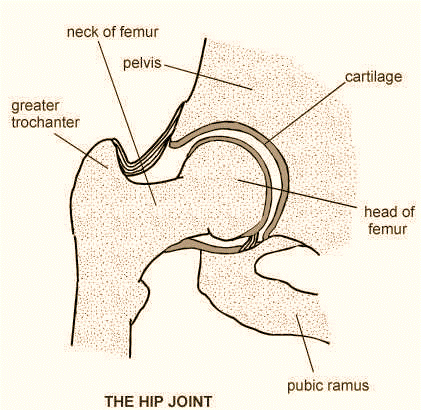
Describe ball and socket joint and hinge joint
Answer
579.3k+ views
Hint: A joint is generally a point where two or more things are connected together.
Joint means an articulation or a strong connection that joins the bones, teeth, and cartilage together. These joints are named according to their structure and function.
Complete answer:
Joints are classified as fibrous, cartilaginous or synovial joints by the type of the tissue present. They can also be classified as synarthrosis, amphiarthrosis or diarthrosis by the degree of movement permitted.
Synovial Joints: Synovial joints have fluid-filled joint cavities contained within a fibrous capsule. They are freely movable joints.
They are further classified as:
Hinge, Saddle, Plane, Pivot, Condyloid, and Ball and Socket type of joints based on their structures, degree and axes of movements.
Ball and Socket Joints: It is a kind of joint where the ball-shaped articulating surface of one rounded bone fits into the cup-like depression of another bone. The distal bone is capable of motion around an indefinite number of axes, with one common centre. This permits free movement along numerous axes and movement in many directions. E.g. hip joint, shoulder joint.

Hinge Joint: A hinge joint is a that allows movement in only one direction. Hinge joints include ankles, elbows, knee joints, and other such joints that have a movement along one plane only. These joints are two or more bones that meet and move along a single axis to bend.
Hinge joints are generally assisted by other tissues, like cartilage and ligaments, to connect and bend. These connective tissues protect the bones from rubbing and wearing as they bend at varying degrees to keep our bodies mobile. Eg- Knee joint, Elbow Joint

Additional Information:
Note: While the Ball and Socket joint allows for a wide range of motions, the hinge has a restricted axis of movement. The other synovial joints like pivot and saddle joints allow for more movement as compared to the hinge joint.
Complete answer:
Joints are classified as fibrous, cartilaginous or synovial joints by the type of the tissue present. They can also be classified as synarthrosis, amphiarthrosis or diarthrosis by the degree of movement permitted.
Synovial Joints: Synovial joints have fluid-filled joint cavities contained within a fibrous capsule. They are freely movable joints.
They are further classified as:
Hinge, Saddle, Plane, Pivot, Condyloid, and Ball and Socket type of joints based on their structures, degree and axes of movements.
Ball and Socket Joints: It is a kind of joint where the ball-shaped articulating surface of one rounded bone fits into the cup-like depression of another bone. The distal bone is capable of motion around an indefinite number of axes, with one common centre. This permits free movement along numerous axes and movement in many directions. E.g. hip joint, shoulder joint.

Hinge Joint: A hinge joint is a that allows movement in only one direction. Hinge joints include ankles, elbows, knee joints, and other such joints that have a movement along one plane only. These joints are two or more bones that meet and move along a single axis to bend.
Hinge joints are generally assisted by other tissues, like cartilage and ligaments, to connect and bend. These connective tissues protect the bones from rubbing and wearing as they bend at varying degrees to keep our bodies mobile. Eg- Knee joint, Elbow Joint

Additional Information:
Note: While the Ball and Socket joint allows for a wide range of motions, the hinge has a restricted axis of movement. The other synovial joints like pivot and saddle joints allow for more movement as compared to the hinge joint.
Recently Updated Pages
Why are manures considered better than fertilizers class 11 biology CBSE

Find the coordinates of the midpoint of the line segment class 11 maths CBSE

Distinguish between static friction limiting friction class 11 physics CBSE

The Chairman of the constituent Assembly was A Jawaharlal class 11 social science CBSE

The first National Commission on Labour NCL submitted class 11 social science CBSE

Number of all subshell of n + l 7 is A 4 B 5 C 6 D class 11 chemistry CBSE

Trending doubts
10 examples of friction in our daily life

One Metric ton is equal to kg A 10000 B 1000 C 100 class 11 physics CBSE

Difference Between Prokaryotic Cells and Eukaryotic Cells

1 Quintal is equal to a 110 kg b 10 kg c 100kg d 1000 class 11 physics CBSE

State the laws of reflection of light

Explain zero factorial class 11 maths CBSE




